

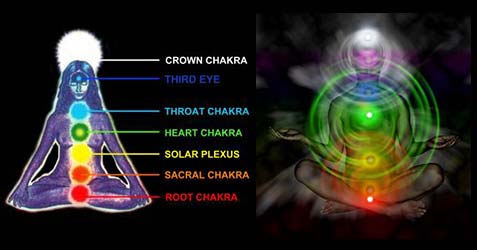
Chakra is a Sanskrit word that translates as wheel or disc or turning. The Chakras are said to be "force centers" or whorls of energy permeating, from a point on the physical body. Seven major chakras or energy centers (also understood as wheels of light) are generally believed to exist, located within the subtle body.
Each Chakra is like a spiral of energy elating to the others. Together the 7 chakras form the energy system of our body. Chakras are controlled by endocrine glands and nervous system. Each chakra is related to one of the endocrine glands in our body. Endocrine glands secrete hormones.
Chakras are typically depicted in two ways:
The Seven Major Chakras:
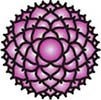
Sahasrara is generally considered to be the chakra of pure consciousness. Its role may be envisioned somewhat similarly to that of the pituitary gland. Symbolized by a lotus with one thousand petals, it is located at the crown of the head. Sahasrara is represented by the colour violet and it involves such issues as inner wisdom and the death of the body. Sahasrara's inner aspect deals with the release of karma, physical action with meditation, mental action with universal consciousness and unity, and emotional action with "beingnness".
Location: Top of head.
Under Active: If it is under-active, you're not very aware of spirituality. You're probably quite rigid in your thinking.
Over Active: If this chakra is over-active, you are probably intellectualizing things too much. You may be addicted to spirituality and are probably ignoring your bodily needs.

Ajna (along with Bindu, is also known as the Third Eye Chakra) is linked to the pineal gland which may inform a model of its envisioning. Ajna is symbolised by a lotus with two petals, and corresponds to the colour white, indigo or deep blue. Ajna's key issues involve balancing the higher & lower selves and trusting inner guidance. Ajna's inner aspect relates to the access of intuition. Emotionally, Ajna deals with clarity on an intuitive level.
Location: Centre of head, behind forehead.
Under Active: If it is under-active, you're not very good at thinking for yourself, and you may tend to rely on authorities. You may be rigid in your thinking, relying on beliefs too much. You might even get confused easily.
Over Active: If this chakra is over-active, you may live in a world of fantasy too much. In excessive cases hallucinations are possible.
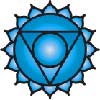
Vishuddha (also Vishuddhi) may be understood as relating to communication and growth through expression. This chakra is paralleled to the thyroid. Symbolised by a lotus with sixteen petals. Vishuddha is characterized by the color light or pale blue, or turquoise. It governs such issues as self-expression and communication. Physically, Vishuddha governs communication, emotionally it governs independence, mentally it governs fluent thought, and spiritually, it governs a sense of security.
Location: Throat area.
Under Active: When this chakra is under-active, you tend not to speak much, and you probably are introverted and shy. Not speaking the truth may block this chakra.
Over Active: If this chakra is over-active, you tend to speak too much, usually to domineer and keep people at a distance. You're a bad listener if this is the case.
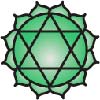
Anahata, or Anahata-Puri, or Padma-Sundara is related to the thymus, located in the chest. Anahata is symbolised by a lotus flower with twelve petals. Anahata is related to the colours green or pink. Key issues involving Anahata involve complex emotions, compassion, tenderness, unconditional love, equilibrium, rejection and well being. Physically Anahata governs circulation, emotionally it governs unconditional love for the self and others, mentally it governs passion, and spiritually it governs devotion.
Location: Midway between shoulders.
Under Active: When your Heart Chakra is under-active, you are cold and distant.
Over Active: If this chakra is over-active, you are suffocating people with your love and your love probably has quite selfish reasons.

Manipura or Manipuraka or Naval Chakra is related to the metabolic and digestive systems. Manipura is believed to correspond to Islets of Langerhans. Symbolised by a lotus with ten petals. The colour that corresponds to Manipura is yellow. Key issues governed by Manipura are issues of personal power, fear, anxiety, opinion-formation, introversion, and transition from simple or base emotions to complex. Physically, Manipura governs digestion, mentally it governs personal power, emotionally it governs expansiveness, and spiritually, all matters of growth.
Location: Above the navel.
Under Active: When the Navel chakra is under-active, you tend to be passive and indecisive. You're probably timid and don't get what you want.
Over Active: If this chakra is over-active, you are domineering and probably even aggressive.

Swadhisthana, Svadisthana or Adhishthana is located in the sacrum and is considered to correspond to the testes or the ovaries that produce the various sex hormones involved in the reproductive cycle. Svadisthana is also considered to be related to, more generally, the genitourinary system and the adrenals. The Sacral Chakra is symbolized by a lotus with six petals, and corresponds to the colour orange. The key issues involving Svadisthana are relationships, violence, addictions, basic emotional needs, and pleasure. Physically, Svadisthana governs reproduction, mentally it governs creativity, emotionally it governs joy, and spiritually it governs enthusiasm.
Location: Behind and just below the navel.
Under Active: If you tend to be stiff and unemotional or have a "poker face," the Sacral chakra is under-active. You're not very open to people.
Over Active: If this chakra is over-active, you tend to be emotional all the time. You'll feel emotionally attached to people and you can be very sexual.
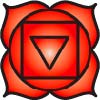
Muladhara or Kundalini or Root chakra is related to instinct, security, survival and also to basic human potentiality. This centre is located in the region between the genitals and the anus. Muladhara is symbolized by a lotus with four petals and the colour red. Key issues involve sexuality, lust and obsession. Physically, Muladhara governs sexuality, mentally it governs stability, emotionally it governs sensuality, and spiritually it governs a sense of security.
Location: Base of spine and the pubic bone and includes genitals and reproductive organs.
Under Active: If you tend to be fearful or nervous, your Root Chakra is probably under-active. You'd easily feel unwelcome.
Over Active: If this chakra is over-active, you may be very materialistic and greedy. You're probably obsessed with being secure and resist change.
| Chakras & Sound | |||
| No | Chakra | Note | Color |
| 8 | C | ||
| 7 | Crown | B | Violet |
| 6 | Third Eye / Brow | A | Indigo |
| 5 | Throat | G | Blue |
| 4 | Heart | F | Green |
| 3 | Solar | E | Yellow |
| 2 | Sacral | D | Orange |
| 1 | Base | C | Red |
Click here to take this free chakra test to find out how open each of your seven chakras is.
Click here to Open Your Chakras: Chakra meditations that use mudras and sounds to open chakras.